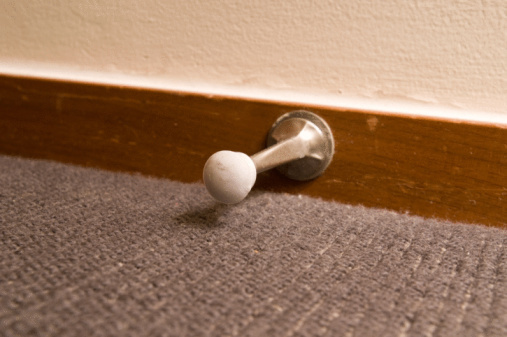Two types of doorstops have advantages, disadvantages
QSeveral months ago, I paid to have a hole patched in my wall that the doorknob had punched through the drywall. Well, the hole is back again and I realized that there is no doorstop to prevent the door from hitting the wall. What type do you recommend?
A: I suppose the type of doorstop doesn’t really matter, so long as you actually have a doorstop. The doorknob punching a hole in your wall should have been your first clue.
There are two styles of doorstops: one that looks like a stick and gets installed either in the base molding of the door itself and one that is installed in the door’s hinge pin.
With the type that screws into the base molding, you have another choice: either a rigid post or a spring. The rigid type is better than the spring because there is no give.
If the door is slammed toward the wall and the spring type isn’t mounted so that the impact is directly centered on it, the spring may give enough so that the handle pops into the wall.
The rigid type won’t do this. However, the rigid type has its own disadvantages. We just happen to have a rigid doorstop at the end of the hall.
When my son misbehaves, he gets sent to “time-out” at the end of the hall (for nonparents, this is the equivalent of lockdown for first-time offenders). So what is an angry child supposed to do on his way to lockdown? Why he stomps on the rigid doorstop, of course. This pulls out of the cheap fiberboard base molding and creates another weekend chore.
If you have really nice base molding, you may not want to put a hole in it. Instead, you can use a hinge pin doorstop. These have padded adjustable arms and work well.
If you want to stick with a rigid or spring doorstop, check the sweep of the door and measure in about 1½ inches from both the bottom and side edges of the door. Drill a one-eighth inch pilot hole and screw it in. For the spring type, you simply screw in the base and then twist in the spring stop.
For the hinge pin doorstop, it is equally easy. Buy one that matches the finish on the hinges. Use a screwdriver to pry up the hinge pin from the top hinge. Set the doorstop on top of the hinge and push the pin through the stop and finally through the hinge.
Adjust the hinge stop by turning the setscrew to the desired distance. These types of doorstops work well for lightweight, hollow-core interior doors. If the door is heavy, install a second hinge stop in the bottom hinge as well. If you don’t do this and someone applies significant force to the door, it could damage the hinge.
Mike Klimek is a licensed contractor and owner of Las Vegas Handyman. Questions may be sent by email to: handymanoflasvegas@msn.com. Or, mail to: 4710 W. Dewey Drive, No. 100, Las Vegas, NV 89118. His Web address is www.handymanoflasvegas.com.




























